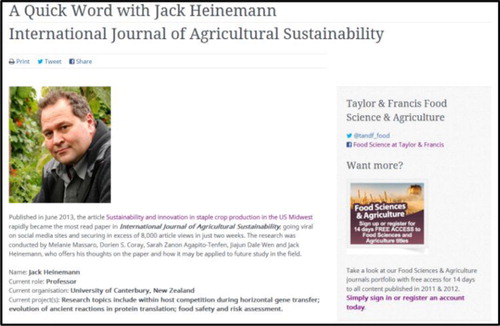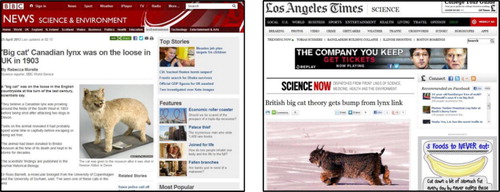Marketers of academic journals are all too aware of the competition for readership that an individual article faces on publication. With numerous papers published on similar topics, an author can assist with the marketability of their article from the very start with a “Google-able” title. A paper published in Journal of Sustainable Tourism recently amassed over 2,000 unique downloads and 20 citations in its first 12 months online, without any specific marketing undertaken for it. The title of the paper? ‘Can Sustainable Tourism Survive Climate Change?’Citation1. This example teaches that by using keywords that are likely to be searched the most frequently, an article is instantly more search-engine friendly, giving it a visibility to the electronic world that sometimes, a marketer is unable to achieve.
However, there are some articles that will generate media attention if the correct marketing strategy is established; a strategy, which often hinges on notification from a journal Editor that a newsworthy article is going to be published, that begins with the author and ends with global dissemination through a press release by the journal marketer. A best practice for press releases of newsworthy articles and how an editor can get better involved is explored, with examples, in this paper.
So, how can an Editor ensure that their journal is getting maximum exposure in such a competitive academic market? The simple answer is by keeping an eye out and prioritising, if possible, those articles that are likely to have most impact both in the academic and public realms, and notifying the marketer when an article is likely to publish online. This already places the article one step ahead of the competition.
But what defines a ‘newsworthy’ article? There is no simple answer to this question; however, results have shown that often they are papers focusing on human interest research, such as psychology, scientific discoveries from medicine to new animal species, or simply a paper that covers a topic that happens to be in the media at the time of online publication.
Once an Editor has found a newsworthy article and notified the appropriate marketer, what are the next steps? Some Editors will then take a backseat, leaving the marketer to write a press release (or using copy provided by the Editor/Author), distributing to as many as 5,000 journalist contacts, posting on relevant media wires (i.e. news sites such as Yahoo or Sky News) and supplementing these activities with social media dissemination. However, some Editors take a more active role, furthering the efforts of their marketer by engaging with their own university or organisation press office/officer (if they have one) and encouraging their representatives to also disseminate any press releases. The following examples show that a collaborative approach can significantly increase the readership of an article, securing anything from 2,500 to over 10,000 full-text downloads in less than a month.
The Editor can also call on any contacts they may have, be these colleagues, journalists, students or friends, and generate further interest in the journal article. This is a win–win situation for all, as more downloads of the paper are generated by the people that are most interested in it.
The most successful press release campaign pertaining to an article published by Taylor & Francis to date revolves around an Open Access article in International Journal of Agricultural Sustainability on genetically modified cropsCitation2. The release was disseminated by the University of Canterbury, institution of lead author Jack Heinemann, and supported by a Taylor & Francis email campaign promoting the paper and an interview with Heinemann. News of the article spread rapidly on Twitter, achieving an AltmetricFootnote1 score of 474, and the number of full-text downloads had surpassed 17,000 within six weeks of publication, the majority of which occurring in the first fortnightCitation3. The article not only became the most read in the journal's history, but also significantly amplified the extent to which overall journal usage had increased on the previous year.
Another article to receive widespread attention from a number of high profile media corporations detailed the discovery of a stuffed Edwardian lynx in the basement of a museum, which proved that a ‘big cat’ once roamed wild in the UKCitation4. Published in Historical Biology, the article was the subject of a synchronised press release distributed by both Taylor & Francis and the press offices of all the authors’ institutions, and was covered by numerous global news agencies such as the BBC (including Material World on Radio 4), NBC, LA Times and French Tribune to name but a few. The article was also featured in video content produced by the BBCCitation5. Supported by an email campaign and posting on Taylor & Francis social media and subject news pages, the article became the most read in the journal, amassing in excess of 2,200 full-text downloads.
Perhaps one of the most insightful cases to consider with regards to press releases is of two papers published online in Bioacoustics in July 2013. The first paper, detailing an improved method of identifying wolves only by their howl, had been drawn to the attention of the Environment & Agriculture Editorial Team by Peter McGregor, Editor of the journalCitation6. It was explained that the press office at Nottingham Trent University, the institute of the chief author of the article, were planning to distribute a press release but wanted to discover how Taylor & Francis could assist in the process. It was agreed that free access would be available to the article upon the date of online publication and that the release would be launched as soon as this had been set up. Furthermore, the BBC would be granted exclusivity to the story on account of an existing professional relationship between the university and the broadcasting organisation. Taylor & Francis would supplement this strategy by distributing an email campaign to existing relevant contacts and by posting messages on Twitter and Facebook.
On 22 July 2013, the paper was published and the BBC, having had over a week to prepare, ran with news of the story on the front page of their Science & Environment and Nature news pagesCitation7. The BBC also later featured video content of author, Holly Root-Gutteridge, talking about her researchCitation8. This cooperative promotion of the article not only raised awareness of the journal via one of the biggest international broadcasting corporations in the world, but also secured 2,500 full-text downloads of the article in less than a fortnight, making the article the most read paper in the journal.
Conversely, the second paper from the journal to be the subject of a press release at the same time, a piece on ‘the biomechanics of sound production in the neotropical predaceous katydid Arachnoscelis arachnoides’, achieved less than 100 full-text downloads in the same period of timeCitation9. In this case, the press release was coordinated by a university in the UK, while Taylor & Francis supported by providing free access to the paper and promoting news of this via the relevant social media pages and subject news pages. While one may validly argue that the difference in success of these two press releases is due to the extent to which the general public show interest in the subject matter, this also highlights the advantages of building a network of journalists who write on the subject area of the journal(s) being promoted.
Indeed, the acquisition of influential contacts was also a key factor in the vast success of another press release on Italian comedian Beppe Grillo running for presidency in his home nation, distributed by the Routledge Area Studies marketing teamCitation10. In this instance, the Editors of the journal, South European Society and Politics, were well connected with members of the Italian media and the story was picked up by La RepubblicaCitation(11). This distribution throughout the Italian media caused news of the story to go viral and, coupled with the additional marketing efforts employed by Routledge, the article quickly became the most read in the journal with in excess of 11,000 full-text downloads.
As the Journals Marketing department have continued to distribute press releases throughout 2013, the solutions to producing effective press releases to promote our content have become increasingly clearer. While there are several aspects to consider with regards to best practice in the distribution of a press release, the most important of all is good communication. For the most part, marketers are not experts in the fields for the subjects of their journals, meaning a healthy rapport with external associates such as Editors and authors, and colleagues in their editorial and production teams is imperative in the successful transfer of intelligence. Editors and authors will be the first to know if a forthcoming paper is likely to be of interest to the general public or one which is of significant importance to the academic community, so marketers should encourage them to provide notification at the earliest opportunity.
Equally important in the distribution of a press release is timing. In the first instance, the sooner the marketer is aware of a paper potentially suitable for a press release the better. But it is then vital to follow a process when carrying out the distribution. If the article in question is yet to be published, the press release should be delayed until the paper is available online with free access. If already published, the release should be delayed until free access has been arranged. This is crucial as journalists will want to understand the content before making their decision to write about it. Journalists generally also prefer time to gather further information and sometimes conduct interviews or create supplementary material such as video content when compiling their news stories, so it is also good practice to distribute a release with an embargo period of 48 hours to allow for this. In instances where the marketer may wish to offer exclusivity to a specific news outlet, as was the case with the Bioacoustics article, the press release should only be distributed once the story has been published by the journalist.
In the instance of said Bioacoustics article, the contact at the BBC to whom exclusivity was granted was originally a preferred contact of the press office at Nottingham Trent University. As is often the case, an institutional press office may be the first to suggest distributing a release before contacting Taylor & Francis for assistance and it may transpire that both parties wish to disseminate news in this way. If this is the case, it is possible that journalists may receive the news from more than one source, making it imperative that all releases contain identical copy and are distributed simultaneously so as to avoid any confusion upon receipt. Alternatively, marketers may wish to leave the press release to the institutional press offices and supplement the overall effort with news of the article in email campaign to relevant existing contacts and by posting on social media platforms and subject news pages.
Thus far, this article has discussed best practice with regards to the action of distributing a press release, but it is equally crucial to understand what constitutes appropriate content for a press release. Simply, any article published by Taylor & Francis which is likely to be of interest to the general public as well as the academic community, which details a new discovery or novel approach, which may have significant impact upon the field of study, or which relates to current affairs, or topical debate should be considered for promotion via a press release. New journal launches, the publication of Special Issues, Editorial Board changes, Impact Factor announcements and general marketing campaigns around journals are not worthy of press releases and are likely only to succeed in irritating journalists who have little time to sift through numerous communications such as these on a daily basis. As suggested in a recent talk to Taylor & Francis by Charles Arthur, the current Technology Editor at The Guardian, a press release must detail something out of the ordinary, involve identifiable people, demonstrate conflict and identify changeCitation12. Where possible, the press release should ‘tell a story’ in order for it to command interest and warrant news coverage.
Marketers across all industries, not just publishing, understand that the practice of marketing ‘never changes in its essentials … [and] is still all about creating awareness and desire among potential customers’Citation13. Thus, with a successful press release, the visibility of a journal increases, not only within the academic community, but also within the media and public realm. With more people taking notice of an article from the journal, the target market becomes even more engaged. This does not purely mean librarians and institutions wanting to subscribe as a result of the beneficial media coverage, but all of the positive things that can happen as a result.
Increased readership means that there is a good chance of an increase in citations, which impacts positively on the Impact Factor (should the journal have one) and should result in more high quality submissions to the journal. As a consequence, more people tend to take note of the journal and again, read/cite papers, or even request acceptance onto the Editorial Board. This is the ideal, but it just goes to show that from a relatively low-effort activity, the journal could be propelled into a cycle of greatness, where benefits are reaped across the board.
Additional information
Notes on contributors

Matt Peck
Matt Peck has worked in the Marketing Department at Taylor & Francis for over three years and has spent the last 12 months within the Life Sciences, covering Zoology, Plant Science and Aquaculture journals. As Senior Marketing Executive, responsible for a wide portfolio of publications, Matt focuses on both large projects and individual journal needs, working within a small team of dedicated Environment & Agriculture marketers, where work is shared and delegated to ensure optimum visibility for relevant content. With key involvements, both in the UK and abroad, Matt provides marketing assistance and provision to the NISC portfolio as well as concentrating a great deal of his efforts towards institutional free trials in Asia, especially the South East and China, whilst managing the day-to-day demands of individual titles that he works on. No day is ever the same, but if you are looking for article downloads and increased citations then you are in the right place.

Andy Hall
Andy Hall has worked in the Marketing Department at Taylor & Francis for over two years, most recently taking care of the Environmental Science & Policy, Food Science & Agriculture, Palaeontology, Veterinary Science, and Water Science & Resources portfolios as Marketing Executive since December 2012. A member of the Environment & Agriculture Journals Marketing team, Andy manages not only the requirements of individual titles and larger subject portfolio campaigns, but is also proactive in promoting the wider offerings of the business as a whole. Formerly a corporate film producer, Andy specialises in digital media communications and social media marketing.
Notes
1. Altmetric.com monitors social media sites, newspapers, government policy documents and other sources for mentions of scholarly articles, bringing all the attention together to compile article level metrics.
References
- Weaver D. Can sustainable tourism survive climate change? Journal of Sustainable Tourism [Internet]. 2011 [ cited 2013 Aug 19]; 19:5–15. Available from: http://www.tandfonline.com/doi/full/10.1080/09669582.2010.536242
- Heinemann JA. et al. Sustainability and innovation in staple crop production in the US Midwest. International Journal of Agricultural Sustainability [Internet]. 2013 [cited 2013 Aug 19]. Available from: http://www.tandfonline.com/doi/full/10.1080/14735903.2013.806408
- Altmetric.com. Article details. [Internet]. 2013 [cited 2013 Aug 19]. Available from: http://www.altmetric.com/details.php?key=90e493dd30bec95f3055990072a03504&citation_id=1565727&embedded=true
- Blake M. et al. Multidisciplinary investigation of a ‘British big cat’: a lynx killed in southern England c. 1903. Historical Biology [Internet]. 2013 [cited 2013 Aug 19]. Available from: http://www.tandfonline.com/doi/abs/10.1080/08912963.2013.785541
- bbc.co.uk. BBC News – ‘Big cat’ Canadian lynx was on the loose in UK in 1903 [Internet]. 2013 [cited 2013 Aug 19] Available from: http://www.bbc.co.uk/news/science-environment-22263874
- Root-Gutteridge H, Bencsik M, Manfred Chebli M, Louise K. Gentle, Christopher Terrell-Nield, Alexandra Bourit & Richard W. Yarnell. Identifying individual wild Eastern grey wolves (Canis lupus lycaon) using fundamental frequency and amplitude of howls. Bioacoustics [Internet]. 2013 [cited 2013 Aug 19]. Available from: http://www.tandfonline.com/doi/full/10.1080/09524622.2013.817317
- bbc.co.uk. BBC Nature – Wolf howl identification technology excites experts. [Internet]. 2013 [cited 2013 Aug 19]. Available from: http://www.bbc.co.uk/nature/23263266
- bbc.co.uk. BBC News – ‘I've howled to the wolves and they howled back’ says researcher. [Internet]. 2013 [cited 2013 Aug 19]. Available from: http://www.bbc.co.uk/news/science-environment-23405105
- Chivers B. et al. Ultrasonic reverse stridulation in the spider-like katydid Arachnoscelis (Orthoptera: Listrosceledinae). Bioacoustics. [Internet]. 2013 [cited 2013 Aug 19]. Available from: http://www.tandfonline.com/doi/full/10.1080/09524622.2013.816639
- Bordignon F, Ceccarini L. Five Stars and a Cricket. Beppe Grillo Shakes Italian Politics. South European Society and Politics [Internet]. 2013 [cited 2013 Aug 19]. Available from: http://www.tandfonline.com/doi/full/10.1080/13608746.2013.775720
- repubblica.it. La Repubblica [Internet]. 2013 [cited 2013 Aug 19]. Available from: http://www.repubblica.it/
- Arthur C. Marketing Hub. Speech presented at: Taylor & Francis Headquarters. 201305; Abingdon, Oxfordshire.
- Hauer C. Marketing in the digital age. Editors' Bulletin [Internet]. 2012 [cited 2013 Aug.19]; 7:3, 77–79. Available from: http://www.tandfonline.com/doi/full/10.1080/17521742.2011.685643

